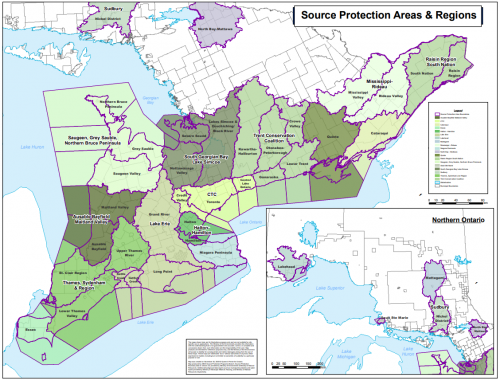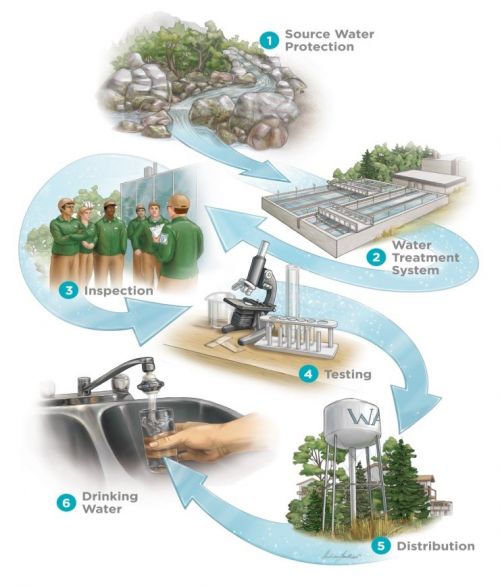Difference between revisions of "Source Water Protection"
| Line 1: | Line 1: | ||
[[File:Source Protection regions map.PNG|thumb|500px| Image of the 19 Source Protection Regions (SPRs) and Source Protection Areas (SPAs) in Ontario (Conservation Ontario, 2022)<ref>Conservation Ontario. 2022. Best Practices for Source Water Protection. Accessed 27 May 2022: https://conservationontario.ca/conservation-authorities/source-water-protection/</ref>.]] | |||
{{TOClimit|3}} | {{TOClimit|3}} | ||
==Overview== | ==Overview== | ||
Spurred mainly by the [https://environmentaldefence.ca/2020/06/01/walkerton-tragedy-ontario-new-water-crisis/ Walkerton Tragedy] in May of 2000, where 2,500 residents of the town fell ill due to ingesting high levels of E.coli bacteria and 7 individuals died due to poor monitoring and maintenance of the drinking water system, the province (Scarfone, 2020)<ref>Scarfone, K. 2020. 20 years after the Walkerton Tragedy, Ontario could be setting itself up for a new water crisis. Safeguarding Freshwater. Environmental Defence. 1 June 2020. Accessed 26 May 2022. https://environmentaldefence.ca/2020/06/01/walkerton-tragedy-ontario-new-water-crisis/</ref> took major overhauling actions to ensure Ontarians drinking water was adequately protected. | Spurred mainly by the [https://environmentaldefence.ca/2020/06/01/walkerton-tragedy-ontario-new-water-crisis/ Walkerton Tragedy] in May of 2000, where 2,500 residents of the town fell ill due to ingesting high levels of E.coli bacteria and 7 individuals died due to poor monitoring and maintenance of the drinking water system, the province (Scarfone, 2020)<ref>Scarfone, K. 2020. 20 years after the Walkerton Tragedy, Ontario could be setting itself up for a new water crisis. Safeguarding Freshwater. Environmental Defence. 1 June 2020. Accessed 26 May 2022. https://environmentaldefence.ca/2020/06/01/walkerton-tragedy-ontario-new-water-crisis/</ref> took major overhauling actions to ensure Ontarians drinking water was adequately protected. | ||
| Line 12: | Line 13: | ||
*'''Source Protection Region (SPR)''': Encompass one or more source protection areas (ex. Credit Valley-Toronto and Region-Central Lake or simply the CTC Region). | *'''Source Protection Region (SPR)''': Encompass one or more source protection areas (ex. Credit Valley-Toronto and Region-Central Lake or simply the CTC Region). | ||
*'''Source Protection Area (SPA)''': Smaller geographic areas generally based on the watershed boundaries of Ontario's 36 Conservation Authorities}} | *'''Source Protection Area (SPA)''': Smaller geographic areas generally based on the watershed boundaries of Ontario's 36 Conservation Authorities}} | ||
[[File:Multi-barrier-safe-drinking-water-co.jpg|thumb|500px|Ontario’s [https://www.ontario.ca/laws/statute/06c22 Clean Water Act, 2006] is the primary piece of legislation within the province to ensure that there is a multi-barrier approach to ensure not only clean and safe drinking water, but by ensuring usage is sustainable and protects lakes, rivers, wells and other major sources of freshwater for ~14.5 million residents (Photo Source: Conservation Ontario, 2016)<ref>Conservation Ontario. 2016. Protecting Our Sources of Drinking Water: Implementation of Source Protection Plans across Ontario. Written by: Chitra Gowda, 11 Oct. 2016. Accessed 27 May 2022: https://ijc.org/en/protecting-our-sources-drinking-water-implementation-source-protection-plans-across-ontario</ref>]] | |||
Under the Clean Water Act local multi-stakeholder source protection committees were developed for each region. Each committee is comprised on the region's leading researchers, professionals and technical personnel that help identify significant current and potential future threats to their local municipal drinking water sources. Their job is to regularly meet and develop preventative plans to address identified and theorized threats (Lake Erie Source Protection Region, 2022)<ref>Lake Erie Source Protection Region. 2022. The Clean Water Act. Accessed 26 May 2022. https://www.sourcewater.ca/en/how-it-works/The-Clean-Water-Act.aspx</ref> | Under the Clean Water Act local multi-stakeholder source protection committees were developed for each region. Each committee is comprised on the region's leading researchers, professionals and technical personnel that help identify significant current and potential future threats to their local municipal drinking water sources. Their job is to regularly meet and develop preventative plans to address identified and theorized threats (Lake Erie Source Protection Region, 2022)<ref>Lake Erie Source Protection Region. 2022. The Clean Water Act. Accessed 26 May 2022. https://www.sourcewater.ca/en/how-it-works/The-Clean-Water-Act.aspx</ref> | ||
Revision as of 19:43, 27 May 2022

Overview[edit]
Spurred mainly by the Walkerton Tragedy in May of 2000, where 2,500 residents of the town fell ill due to ingesting high levels of E.coli bacteria and 7 individuals died due to poor monitoring and maintenance of the drinking water system, the province (Scarfone, 2020)[2] took major overhauling actions to ensure Ontarians drinking water was adequately protected.
Following an inquiry into the Walkerton event, Justice, O'Connor at the time made over 120 recommendations to better protect the province's drinking water, which have now been implemented and are the foundation of the province's drinking water protection framework. The first of these recommendations was that drinking water should be protected by developing watershed-based source water protection plans, which have been in place since 2006 with the adoption of the Clean Water Act (Government of Ontario, 2021)[3]
Source Water Protection in Ontario[edit]
Since the Clean Water Act, 2006 was adopted within the province the original recommendations of the "Walkerton Inquiry" were able to begin to be implemented. The legislation required municipalities protect their drinking water sources and supplies through prevention by developing collaborative large-scale watershed-based source protection plans or source water protection (SWPP) based on monitoring results and the latest science. When the Clean Water Act was first established the province paid for the cost of developing the preliminary SWPPs.
Under the Clean Water Act the legislation describes newly developed source water protection areas and source water protection regions.
- Source Protection Region (SPR): Encompass one or more source protection areas (ex. Credit Valley-Toronto and Region-Central Lake or simply the CTC Region).
- Source Protection Area (SPA): Smaller geographic areas generally based on the watershed boundaries of Ontario's 36 Conservation Authorities

Under the Clean Water Act local multi-stakeholder source protection committees were developed for each region. Each committee is comprised on the region's leading researchers, professionals and technical personnel that help identify significant current and potential future threats to their local municipal drinking water sources. Their job is to regularly meet and develop preventative plans to address identified and theorized threats (Lake Erie Source Protection Region, 2022)[5]
Source Protection Plans (SPP)[edit]
Source protection plans (SPPs) contain a number of policies that are locally developed by their local technical committees aimed at protecting existing and future spruces of adequate drinking water sources for impacted municipalities.
The associations who are reporting and implementing SPP policies and progress annually include:
- Conservation Authorities;
- Municipalities;
- Source protection authorities;
- Local health boards;
- Indigenous groups, committees and governments;
- Local businesses
- The Province of Ontario; and,
- Others (Government of Ontario, 2021)[3]
Under the Clean Water Act, 2006 a total of 19 SPRs and SPA's have been established across the province. Each of these 19 SPRs/SPAs contain their own local multi-stakeholder source protection committees across the province which have developed 38 local source protection plans. These specialized plans identify various actions to protect over 450 affected municipal drinking water systems (covering 95% of Ontario's population) (Government of Ontario, 2021)[3].
SPRs & SPAs in Ontario[edit]
Listed below are 19 different SPRs and SPAs in Ontario, where you can visit each Region's/Area's dedicated Sourcewater protection website for information on their committee members, recent reports, helpful documents, informational videos and the like:
- Ausable Bayfield Maitland Valley Source Protection Region
- Cataraqui Source Protection Area
- CTC Source Protection Region
- Essex Region Source Protection Area
- Greater Sudbury Source Protection Area
- Halton-Hamilton Source Protection Region
- Lake Erie Source Protection Region
- Lakehead Source Protection Area
- Mattagami Region Source Protection Area
- Mississippi-Rideau Source protection Region
- Niagara Peninsula Source Protection Area
- North Bay-Mattawa Source Protection Area
- Quinte Region Source Protection Area
- Raisin-South Nation Source Protection Region
- Saugeen, Grey Sauble, Northern Bruce Peninsula Source Protection Region
- Sault Ste. Marie Region Source Protection Area
- South Georgian Bay Lake Simcoe Source Protection Region
- Thames-Sydenham Source Protection Region
- Trent Conservation Coalition Source Protection Region
Planning Considerations[edit]
Inclusion of the tools and atlas
- Recommendations - refer to SPP (pull from B.C's recommended practices)
- Top lessons and maintenance (setback distances / replacing media)
Talk about pretreatment - filtration before being sent directly to groundwater source (bioretention/swale -> infiltration trench) Online vaults from minor system flows (filter and target specific pollutants) - before infiltration.
Site Considerations[edit]
Site Specific Jurisdictions[edit]
Source Water Protection Nationally[edit]
Nova Scotia[edit]
British Columbia (B.C)[edit]
Pretreatment Features[edit]
Design Features[edit]
References[edit]
- ↑ Conservation Ontario. 2022. Best Practices for Source Water Protection. Accessed 27 May 2022: https://conservationontario.ca/conservation-authorities/source-water-protection/
- ↑ Scarfone, K. 2020. 20 years after the Walkerton Tragedy, Ontario could be setting itself up for a new water crisis. Safeguarding Freshwater. Environmental Defence. 1 June 2020. Accessed 26 May 2022. https://environmentaldefence.ca/2020/06/01/walkerton-tragedy-ontario-new-water-crisis/
- ↑ Jump up to: 3.0 3.1 3.2 Government of Ontario. 2021. Source protection. Environment and Energy - Drinking Water. 13 October 2021. Accessed: 26 May 2022. https://www.ontario.ca/page/source-protection#section-0
- ↑ Conservation Ontario. 2016. Protecting Our Sources of Drinking Water: Implementation of Source Protection Plans across Ontario. Written by: Chitra Gowda, 11 Oct. 2016. Accessed 27 May 2022: https://ijc.org/en/protecting-our-sources-drinking-water-implementation-source-protection-plans-across-ontario
- ↑ Lake Erie Source Protection Region. 2022. The Clean Water Act. Accessed 26 May 2022. https://www.sourcewater.ca/en/how-it-works/The-Clean-Water-Act.aspx